#It Is Not the Homosexual Who Is Perverse But the Society in Which He Lives
Explore tagged Tumblr posts
Text
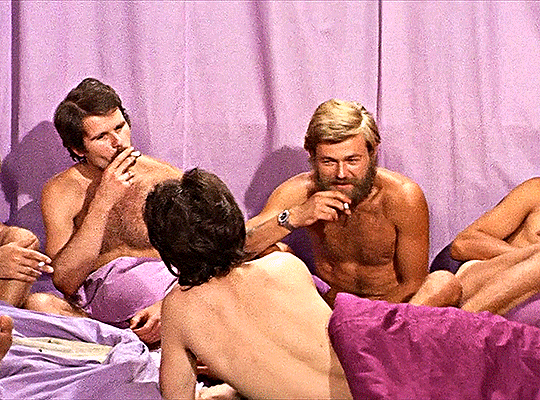
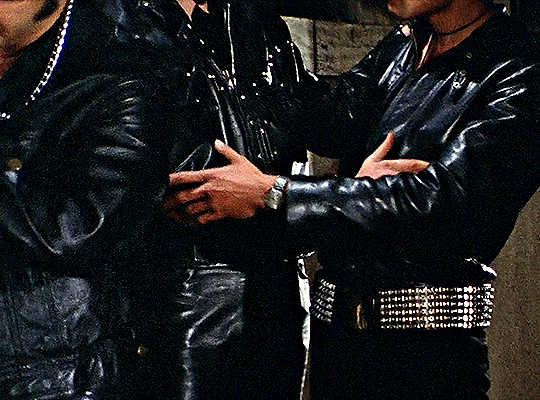



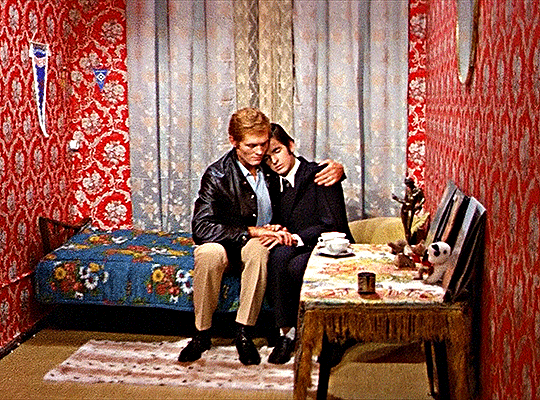
It Is Not the Homosexual Who Is Perverse, But the Society in Which He Lives (1971) dir. Rosa von Praunheim
#It Is Not the Homosexual Who Is Perverse But the Society in Which He Lives#Nicht der Homosexuelle ist pervers sondern die Situation in der er lebt#Rosa von Praunheim#Berryt Bohlen#Bernd Feuerhelm#vintage gay#guys#movies#gay kiss#lgbt media#gay leather#*#**#filmedit#lgbtedit#holesrus#userlenie#userpedro#userkarlo#kazeo2se#smoking
4K notes
·
View notes
Text
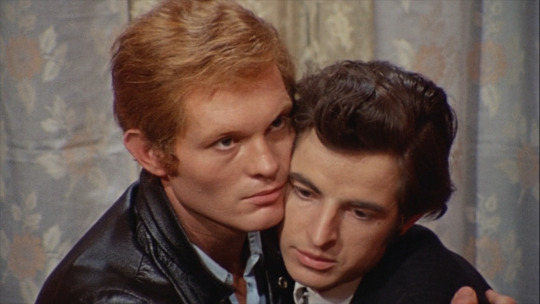



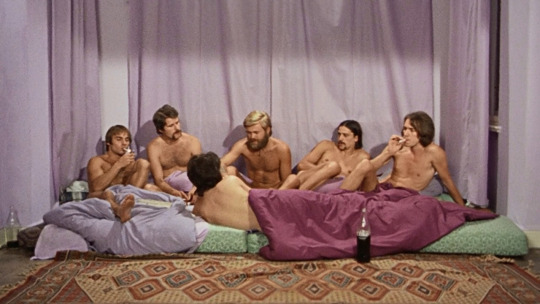
Nicht der Homosexuelle ist pervers, sondern die Situation, in der er lebt / It Is Not the Homosexual Who Is Perverse, But the Society in Which He Lives (1971) - Rosa von Praunheim
Die bürgerliche Ehe funktioniert durch Aufzucht von Kindern und Unterdrückung der Frau. Die Schwule Ehe kann nur ein lächerlicher Abklatsch sein, da fehlende gemeinsame Aufgaben ersetzt werden durch eine romantische Liebe; die fern jeder Realität ist. // Bourgeois marriage hinges on child-breeding and the oppression of women. Gay marriage can only be a ridiculous imitation, since the lack of common tasks is replaced by a romantic love that is far removed from any reality.
#nicht der Homosexuelle ist pervers sondern die situation in der er lebt#it is not the homosexual who is perverse but the society in which he lives#rosa von praunheim#film#film still#quote#watched in st louis#watched in march 2024
12 notes
·
View notes
Text
I've finally watched "It Is Not the Homosexual Who Is Perverse, But the Society in Which He Lives". I'm still not a fan of Rosa von Praunheim, but the film does make some interesting points which are still relevant today. (Others seem really weird from today's POV.) Still strange to me that this movie basically sparked the modern German queer movement, in the end it's telling people to come out (and to out other queer people), otherwise they won't "be free". It's a very different narrative compared to Stonewall.
However, even more fascinating from the movie is the audience discussion that was recorded and broadcast a year after the TV premiere. I mean, the movie was a huge shock at the time, considering that it's amazing how calm everyone is. There's one person disagreeing with the movie at length and someone in the audience just starts whistling. Not loud or anything, just a jaunty little melody, it's so funny.
And one woman explains something that it very interesting to me: The movie is not made for a straight audience, it's for gay people. It's message is directed at gay people. I mean, logically I knew that but it somehow surprised me to hear it.
5 notes
·
View notes
Note
i get like half my media recs from this blog. you just get it. gay shit. freak shit. gay freak shit. two guys that hate each other tearing one another apart with their bare hands. catholicism. you know what i mean ????
mwah. kissing u on the mouth sloppy style <3
#since we're already here. watch the singer not the song (on ok.ru) for campy fag shit#watch like minds for crazy catholic gay sex & oedipus complexes#watch it is not the homosexual who is perverse. but the society in which he lives to have ur brain rearranged#and read autobiography of red & the sparrow to feel like killing urself#ask
11 notes
·
View notes
Text
shut up about twink death and go watch the final scene of It Is Not the Homosexual Who Is Perverse, But the Society in Which He Lives (1971)
183 notes
·
View notes
Note
Gayboy horror
Hellbent
Strangers by the lake
Nightmare on elm street part 2
Gregg Araki
The living end
Totally fucked up
Nowhere
Gayboy general
Velvet Goldmine
Querelle
It Is Not the Homosexual Who Is Perverse, But the Society in Which He Lives
Beachrats
Happy Together
Thank you so much for the recommendations but I really really like that the three possible categories of gay movies are “Gayboy horror” “Gregg Araki” and “Gayboy general” 💗
35 notes
·
View notes
Text
“Sex and reproduction affected women’s lives much more powerfully than men’s. The mid-century decades were particularly treacherous ones because the codes of sexual conduct were changing so rapidly. On the one hand, traditional sexual mores and the “double standard” remained so strong that a woman’s reputation could be “ruined”--in the lingo of the day--if she behaved in ways that were outside the boundaries of acceptable sexual conduct for women. If she became pregnant as a result, the consequences were extremely dire. On the other hand, these were the years when sex became big business; sex was used to sell products from cars to toothpaste.
Magazines, movies, and every form of advice literature encouraged women to be attractive and sexy to catch a man--but to put on the brakes when it came to sex itself. Birth control devices were becoming more effective and available, but abortion remained illegal except under exceptional circumstances, and illegal abortions were extremely dangerous. If women were confused by all these mixed messages, it is no wonder. As one woman recalled, “Postwar America was a society with Stop-Go lights flashing everywhere we looked. Sex, its magic spell everywhere, was accompanied by the stern warning: Don’t do it.”
…It was now obvious that homosexuality, once considered a deviant fringe element of society, was pervasive. But in the hostile climate of the Cold War years, this knowledge did little to make life easier for gay men and lesbians. In fact, the postwar era was a time of heightened persecution of homosexuals. Anyone who did not display the appropriate sexual behavior of the era--heterosexual dating, young marriage, and childbearing--was suspected of being a “pervert.” This pejorative term was widely used during these years and implied not only sexual deviance, but danger. The Republican party national chairman, Guy Gabrielson, claimed that “sexual perverts… have infiltrated our Government in recent years,” and they were “perhaps as dangerous as the actual Communists.”
It was widely believed that only “manly” men could stand up against the threat of communism, and that “perverts” were security risks. The persecution of homosexual men and women became more intense than ever before. Homophobia became ferocious, destroying careers, encouraging harassment, and forcing homosexuals to name others with whom they associated. In 1950, the Senate issued a report on the Employment of Homosexuals and Other Sex Perverts in Government, which asserted that, “those who engage in overt acts of perversion lack the emotional stability of normal persons… Indulgence in acts of sex perversion weakens the moral fibre of the individual.”
Male homosexuals were considered the greatest menace. Lesbians were also condemned, but since displays of affection between women were not uncommon, lesbianism more easily went unnoticed. Nevertheless, lesbians established strong communities with distinctive styles of dress, behavior, and social institutions. Lesbians who were open about their identity faced extreme hostility and even violence.
…Dating began the path to marriage. Most young people dated during high school, and many, especially young working-class women who did not go on to college, married right after graduation. The dating system established a certain amount of physical intimacy between unmarried men and women. Although the proportion of young men and women having sexual intercourse did not increase substantially between the 1920s and the 1960s, there was a significant increase in physical intimacy that stopped short of intercourse. As Kinsey noted, “on doorsteps and on street corners, and on college campuses, [petting] may be observed in the daytime as well as in the evening hours.” He claimed that petting was “one of the most significant factors in the sexual lives of high school and college males and females.”
Dating and petting in high school often encouraged young coupling, and those who were steady dates were more likely to become sexually involved. One teenager explained that it had more to do with love than with sexual experimentation: “Something you go all the way in should only be with someone you really love, not just any date.” Although adults at the time were sometimes alarmed at what they saw as promiscuous behavior, dating and petting, and even intercourse between steadies, was part of a system of dating that was expected to lead, ultimately, to the rational choice of a marriage partner.
The dating and petting system, however, contained many dangers for women. It was very difficult for a young woman to know how to avoid being a “prude,” and at the same time to know how far was “too far” to go and still maintain her reputation and desirability. The “double standard” was fiercely enforced, which meant that boys could experiment sexually with little risk, but girls were condemned if they did so.”
- Elaine Tyler May, “Sex: Dating, Marriage, and the Double Standard.” in Pushing the Limits: American Women, 1940-1961
28 notes
·
View notes
Note
Huh! I've never watched Fight Club before but I'm sure you're correct in that it's very transgender. Can you elaborate on that? :0
It's no secret at this point that the original book was written with a lot of homoerotic subtext as the author was a gay man who got the idea for the book following being hate crimed, and as such a popular school of thought is that Tyler to an extent represents sexual repression presenting as toxic masculinity.
However, Fincher is not one to make a movie without adding his own flair and interpretations, and Fincher has this really interesting consistent thread in his work wherein all the women are just inherently leading better lives than the self destructive and/or dangerous men running the film, and when a women is self destructive or dangerous it's BECAUSE of how society treats women rather than an internal problem.
And that's where Marla Singer's role gets upped from small(er) time character to important thematic core. Marla is, much like Tyler, seen as a mirror to our protagonist. She's a hot mess with a drug problem, sure. But she's confident in herself in a way our protagonist isn't. Shes bold, she knows what issues she has, and she knows how she likes to handle them. Shes put herself together best she can and chooses to let that which does not matter truly slide.
Tyler makes it a point to have sex with her to hurt the protagonist, while also despising her with a genuine anger that he has for nothing else-even the society he claims to rage against. Then, when our protagonist realizes that he and Tyler are the same his solace is turning to Marla for help which enrages Tyler so much he attempts to kill her.
The final shot after our protagonist kills Tyler is him holding hands with Marla (who in comparison to the All Time Low main here is looking her absolute best in the film) where he says the line:
"You've met me at a very strange point in my life"
Now if Tyler originally represents a potential suppressing of homosexual feelings represented by toxic masculinity, and Marla acts very similarly to Tyler in terms of role yet acts as a positive force for getting better, what could this mean about Marla?
Why does our protagonist believe that his life is at its worst when he first meets her for the expressed crime of being a reflection of himself? Why does Tyler appear after the main can't confront his feelings towards her like she can him? Why does Tyler push so hard to keep her and the main apart? Why is our protagonist's acceptance that he likes Marla the thing that makes him see Tyler as the perversion of masculinity he is?
Something to chew on.
18 notes
·
View notes
Text
What to blame for the ones who hide behind civilians? Who to help this week. Homosexuality is not a disease.
You are watching news from the weekly rally at the Russian Embassy in Lisbon. Today is May 18, 14:30.
On May 15, Russian rapper Misha Mavashi posted a video on his Telegram channel of a Grad MLRS firing while on the road surrounded by cars stuck in a traffic jam. In his comments, he explained that if the Russian army is “working like this,” “it means there is a permission for that.” https://novosti.dn.ua/ru/news/373813-rossijskij-reper-zasvetil-v-seti-strelbu-grada-iz-belgoroda-po-ukraine
The "Important Stories" media found out that this is the road near Shebekino in the Belgorod region, and the direction of fire corresponds to the territory in the north of the Kharkiv region. https://istories.media/news/2024/05/15/poyavilos-video-strelbi-rszo-grad-iz-probki-grazhdanskikh-avto-pod-belgorodom/
On the “Khodorkovsky Live” channel, international lawyer Sergei Golubok explained that this is “the use of a human shield. The same thing that Hamas does when launching rockets from hospitals… Article 51 of the additional protocol to the Geneva Conventions clearly states this… In this case, this MLRS will be a legitimate target for a Ukrainian strike, and civilians around will be legitimately damaged." https://www.youtube.com/live/DePwmNTB4Zo?feature=shared&t=1081
The "Go by the Forest" project, which helps Russians not participate in this war and tries to stop it, is holding the "Run through the Forest" campaign to raise funds for their work. The first race will be on May 19. In Lisbon we start at 10 AM from the Belem Tower. https://t.me/iditelesom_help/3287
On May 23 at 7 PM in Lisbon, the Sputnik bar will host a charity screening of the documentary film “The Hardest Hour”. This is an honest film about how Ukrainians lived until February 24, 2024 and how their lives changed on that day. https://maps.app.goo.gl/uQseM5w78gyvvvoF7
The screening is in support of the Orphans Feeding Foundation's Bring Kids Back UA program. The Foundation has already been able to return 36 children illegally deported from Ukraine. https://www.orphans-feeding-foundation.org/bring-kids-back-ua-program/
Former municipal deputy Alexei Gorinov asks for help with publicizing the fact that they are trying to fabricate a case of extremism for him. Gorinov is in prison for speaking out against holding a children's drawing competition during the war with Ukraine. https://t.me/alexei_gorinov_2022/713
The repression that suppresses dissent and opens the door to war begins with small, vulnerable groups of people. May 17 is the International Day against Homophobia, Transphobia and Biphobia. On this day in 1990, the WHO General Assembly removed homosexuality from its list of diseases, declaring that "it is not a disease, disorder or perversion." https://www.europarl.europa.eu/topics/en/article/20110513STO19333/17-may-international-day-against-homophobia
The English mathematician Alan Turing did a lot for the invention of the computers that we all use. https://ru.wikipedia.org/wiki/%D0%A2%D1%8C%D1%8E%D1%80%D0%B8%D0%BD%D0%B3,_%D0%90%D0%BB%D0%B0%D0%BD
After the outbreak of World War II, Turing worked to crack the code of the German Enigma cipher machine. Winston Churchill said about it this way: “No one else made the same contribution to our victory in the war.” In 1952, Turing was arrested for a homosexual act, which was illegal then. He was given a choice: prison or treatment, which was essentially chemical castration. He agreed to treatment. He was pardoned only posthumously, in 2013. https://www.bbc.com/russian/society/2014/11/141112_imitation_game_turing
Proofs and links are in the description. Subscribe and help.
3 notes
·
View notes
Text



It Is Not the Homosexual Who Is Perverse, But the Society in Which He Lives (German: Nicht der Homosexuelle ist pervers, sondern die Situation, in der er lebt) is a 1971 German avant-garde film directed by Rosa von Praunheim.
(YOUTUBE)
77 notes
·
View notes
Text

It Is Not the Homosexual Who Is Perverse, But the Society in Which He Lives (1971) dir. Rosa von Praunheim
#It Is Not the Homosexual Who Is Perverse But the Society in Which He Lives#Nicht der Homosexuelle ist pervers sondern die Situation in der er lebt#Rosa von Praunheim#Berryt Bohlen#Bernd Feuerhelm#vintage gay#guys#movies#lgbt media#*#**#filmedit#lgbtedit#holesrus#edit#photography
2K notes
·
View notes
Text
Queer history in Norway
I'm mostly going to be translating one wiki, but this will be a quick overview over queer history in Norway. Mainly to motivate myself to read it, but ask for clarification if I phrase things weirdly. This is pretty much an uncritical translation, I'll probably look further into a couple of these things.
Summary:
while being gay wasn't favored, there were no homophobic laws before christianity came (1170). Over the years one could become an outlaw or be burned at the stake for gay sex. You weren't always punished though, because they didn't want to talk about it. In 1781 there was a marriage between two people who were afab, one who lived as a man, possibly trans (possibly bigender). In 1814 Norwegians got our constitution.
In the 1900's there were "romantic friendships" and "peppermø" (ace/unmarried) culture. World world two happened. In 1972 being gay was no longer criminalized. From 1948 there were a couple queer organizations, who in the end turned into the one known as Fri - organisasjonen for kjønns- og seksualitetsmangfold (Free - the organization for gender/sex and sexuality diversity). It became illigal to discrimiate against gay people in 1981. In 1993 gay people could become partnered, but not adopt nor marry in the church. In 2008 gay people could marry.
Since 2010 no "perversions" have been recognized as mental illnesses (homosexuality from before, fetishes, sadomasochism, transvestism etc.). Since 2012 you haven't been able to send gay asylum seekers back to homophobic countries. 2022 was queer culture year (skeivt kulturår). A ban on conversion therapy is in the works, it's only not out-right supported by KRF (who want to make it more difficult to transition) and FRP (who appear not to care either way). A third gender is going to be introduced legally.
translation note:
I don't know all the nuances of slang for sex, especially not historically, so I'm calling anything that seems like it could be sex sex, I'm including the words so you can do your own research, some may mean getting romantically involved I have no idea. Another thing is that sometimes things are about any non heterosexual orientation (e.g. bisexual, asexual) and the original text just says gay (homofile), then I'll just say gay, it is known as an umbrella term, so maybe it works, idk. Some things may also apply to trans people, but they're rarely mentioned.
Lokal Historie Wiki: Skeiv Historie (queer history from a wiki):
The first time homosexuality is mentioned in history is before christianity came here. Gay men were called feminine and bitches, which was very derogatory. Society seemed to be against them, but we don't know of homophobic laws.
When christianity came laws against homosexuality were made, in year 1170. It was inexcusable, one became an outlaw for having gay sex. ("Um to karmenn blandar seg med kvarandre").
In 1687 with Christian Vs norske lov (norwegian law) you could be burned at the stake for anal sex (sodomy). Not many were punished like that because people didn't want to talk about it in case it inspired more gay sex.
in 1781 a trans guy and a (cis) woman got married. Labels were different, but if he lived like a guy I'll call him a guy.
In the 1800's there were more words for gay "tvitotling", "tvetulle" (two tools), which has been used for intersex (tvekjønna) animals was used to describe people who trancended gender/ broke gender/sex norms (kjønnsoverskridende). Another word was "båing" (both), used about gay men and lesbian women. There are some signs of society not being exclusively negative towards queerness.
In 1814 we got "one of the most progressive constitutions in the world". Also, a university student had to quit his studies and leave the city after being outed as gay, but not legally punished. And people were aware of the Greek society being more accepting of homosexuality/sexuality.
In 1842 Christian Vs norske lov (norwegian law) was superseded by community service or prison time. Having gay sex (incl. lesbian) was called "against nature" ("omgjengelse mot naturen") and still punished. In 1846 three girls were punished for having lesbian sex, one with 1,5 years of community service and two with 15 days of prison with only bread and water. In 1847 they were found not guilty. In 1854 they were convicted for outrageous behavior ("forargerlig oppførsel") instead of unnatural sex.
(1886). Gay men on the other hand had to leave their university and got a lot of drama when people learned they were gay. New term: "kontrærseksualitet" (contrary/deviant sexuality). The idea of "sexual perversion" entered the psychiatry. The "I was born this way"-argument (født sånn-argumentet) got introduced. People thought kinks, fetishes and being gay was caused by masturbation, mental illness or negative external impulses (unsure what the last one means). And people still thought it was contagious.
In 1902 (straffeloven) being gay was further criminalized. Paragraph 213 banned "utugtig omgjøngelse" (lewd/undisiplined sex) between men. Gay men were basically told to be discreet as the law was to be put in to action when it was of concern to the general public (allmenheten). It was completely legal to discriminate towards gay men on the job and hosing markets because being gay was illigal.
Several women in the 1900's lived together in what was called "romantic friendships". Some of these may be percieved as platonic and not everyone in them called themselves lesbians. "peppermø" (literal: pepper maiden) was an unmarried woman over 30 and they were of many orientations, especially many who today probably would have called themselves asexual. They were a community or culture that broke with the heteronormative/heteroamatonormative society, because women were according to norms supposed to get married as early as possible.
1924: Alf Martin Jæger wrote gay fiction, homosexual (homoseksuell) was used for the first time in fiction. 1932: The doctors Karl Evang and Torgeir Kasa wrote an article saying people were born gay and deserved human rights (which was radical at the time). In 1937 a lesbian identity was described in "Følelsers forvirring" (feeling's confusion/the confusion of emotions) by Borghild Krane, and she talked about a demand of marriage for security.
WWII came. The nazis sent gay people to consentration camps with a pink triangle, which has later in time become an important symbol of gay people's struggle and gay visibility as a minority. The Norwegian nazi party (Nasjonal Samling) wanted to make paragraph 213 stricter but didn't succeed. People in gay relationships with Germans could be punished by German (Nazi) law.
In 1949 we got the first gay organization, a local branch of the Danish Forbundet av 1948 (Organization of), but it only lasted half a year. In 1950 Det Norske forbundet av 1948, DNT-48 (The Norwegian Organization of) with Rolf Løvaas as its leader. It became independent from the Danish Forbund av 1948 in 1963. They fought against the paragraph 213 (straffeloven § 213), but also for informing people and solidarity amongst gay people.
In 1961 the first Norwegian trans man (Aker sykehus) and in 1962 the first Norwegian trans woman (Rikshospitalet) got a gender affermative operation.
In 1965 the first gay radio program aired (on NRK). The Norwegian [university] Student's orgnization discussed gay people's situation. And in 1966 FTPN, a trans rights organization, was established, it became independent in 2000 and changed name in 2014 (FTPN still).
In 1972 paragraph 213 was repealed. Kim Friele was at the forefront of this (she died in 2021).
In 1975 Lesbisk Bevegelse (Lesbian movement) was founded. Since DNT-48 had a strong focus on gay men people wanted a lesbian, feminist organization.
In 1966 Åpen kirkegruppe was founded to fight for gay christians. In 1976 Arbeidsgrupper for homofil frigjøring, AHF (working groups for gay liberation) came.
In 1977 being gay was no longer a mental illness according to Norsk Psykiatrisk Forening. In 1982 the state, sosialdepartementet also removed homosexuality as a diagnosis.
There was some in-fighting, so in 1979, to unite everyone Fellesrådet for homofile og lesbiske organisasjoner i Norge, FHO (the common/joint council for gay and lesbian organizations in Norway) was made.
In 1981 paragraph 135a and 394a gave protection for gay people. These paragraphs, though most known as the racism paragraphs (rasismeparagrafene), protect from discrimination based on sexual orientation. They protect from discrimination in employment and housing. Later gay people came the work environment law (arbeidsmiljøloven) in 1998 and 2005.
In 1983 Helseutvalget for homofile (the health committee for homosexuals) was founded. The HIV-epidemic had come, and it affected gay men especially, though it did affect other people as I'm sure everyone knows. It increased stigmatisation, people were calling it "a punishment from God" (protestant christian). In 1987 came Landsforening mot AIDS, LMA (country wide). Kirkens bymisjon (christian organization, does a lot of good stuff) opened Aksept (accept) the first center for HIV-positive people and those sick with AIDS. In 1988 AIDS or HIV was not a valid reason for firing someone. The same year Pluss (plus) was founded for those with HIV. In 1999 LMA and Pluss became one, eventually turning into HivNorge (who, in addition to their HIV stuff, today support a couple of queer organizations)
In 1992 Landsforeningen for lesbiske og homofile (The National Association for Lesbians and Homosexuals) was made from the combination of DNF-48 and Fellesrådet for homofile. Later they expanded their name to add bisexuals and trans people. Since 2016 they've been called Fri - foreningen for kjønns- og seksualitetsmangfold (Free - the organization for gender/sex and sexuality diversity).
In 1993 the partnership law was passed. It let lesbian and homosexual couples have mostly the same rights as heterosexuals through marriage. But they could not adopt nor get married in the church. With religious freedom in mind they didn't instruct the church to change their way. In 2008 a new marriage law came, which made gay (incl. lesbian) people allowed to marry.
Skeiv ungdom was founded in 2004. Skeivsnuen anselag was founded in 2006 as a continuation of Drangeleik (danish, boy game). Oslo fagottkor (fagott isn't a slur in Norwegian, but it's based on the english) was founded in 2004.
In 2010 no "perversions" were any longer recognized as mental illnesses (homosexuality from before, fetishes, sadomasochism). Since 2012 you haven't been able to send gay asylum seekers back to homophobic countries. A ban on conversion therapy is in the works, it's only not out-right supported by KRF (who want to make it more difficult to transition) and FRP (who appear not to care either way). A third gender has been introduced legally.
In 2008 the state made an action plan titled "better life quality for lesbians, gats, bisexuals and trans people". Then the LGBT (LHBT) center was made in 2011 as a knoweledge center from sexual orientation and gender identity. In 2015 Skeivt arkiv (queer archive) was opened. They belong to the University in Bergen (UiB).
2022 was queer culture year (skeivt kulturår). The pride of 2022 there was a shooting at a gay bar in Oslo and Oslo Pride was cancelled.
Further reading:
Tone Hellsund: Currently alive researcher at the university in Bergen who among other stuff has written about "peppermøsamfunnet" (non-partnering women). (bora.uib.no). (ethnologist specialized in gender studies).
Alf Martin Jæger: "Odd Lyng" (gay fiction) in 1924.
Borghild Krane: "følelsers forvirring" (lesbian fiction) in 1937
FRI - foreningen for kjønns- og seksualitetsmangfold.
More organizations (my post of links)
Bergen Open Research Archive. Free to read. Has (among other things) queer studies. Some is in Norwegian, some in English.
queer rights today on Wikipedia
#skeive greier#queerblogging#queer history#norwegian history#norwegian queer history#lgbt#lgbtq history#gay history#norskblogging#13435
44 notes
·
View notes
Text
I’m thirty years old and I still get so fucking angry at the way I was raised and educated by conservative evangelical Christians to believe that there had never been anyone like me (queer) in history who was worthy of mention—that queer people didn’t exist who were happy or successful or did anything at all worth noticing other than be rare cases of family disappointment and societal exile.
Fanfiction was even more of a fantasy world to me because in it people in various historical eras could be gay—in school the fact that many of my favorite writers and poets were gay wasn’t mentioned in class, even as we ostensibly learned about their historical context. And when I researched these people later and found out that so many of them were queer I was so angry. All this time I’d felt I was an embarrassing exception, that I had no one respectable to look up to, no precedent for how I might live in accordance with my actual self. Considering a life outside the one set down for you as normal and acceptable is frightening when you’re raised in that world—the wages of sin is death, etc.
I’m reading a history of the Marquis de Sade’s 120 Days of Sodom and I’m struck by the fact that I still get surprised by the historical presence of queer people, e.g. France’s eighteenth-century sodomite fraternities. A pope was warned about sodomy as early as 1100, when one of the king’s lovers was appointed as a bishop. The 20th-century sexologist Iwan Bloch believed that homosexuality was perverse until he found a 120-year-old manuscript by Sade and came to understand that the behaviors he advocated against had long been present in the population.* Yes, queer behavior has often considered errant and punishable, but it’s been here the whole time.
And though queer advocacy organizations often use those “queer people have always been here” taglines, I think that’s very in-group language, because IME many conservative cishet people don’t have the historical context to understand how true that is, or why it matters.
So now we have this grand conservative movement in the U.S.—one that is itself not new, that is very recycled from earlier eras of backlash against homosexuality—that frames queerness and gender-nonconformance as novel, and uses that basis to argue that it’s insidious and should be eradicated before it spreads deeper into the “normal” “virtuous” population. And an accompanying movement to remove mentions of queerness from education, which will only more deeply entrench these notions—the same ones I grew up with—into the next generation.
It’s just so fucking frustrating to me that western societies have these conversations and realizations about queerness over and over again, and then they’re quashed, over and over again, and we’re still stuck in this cycle of shame and stigma. Hundreds of years of bullshit, because people are so afraid of “deviance.”
* source note: The Curse of the Marquis de Sade by Joel Warner
#cw homophobia#cw transphobia#political posting#anyway check out my Siegfried Sassoon/Wilfred Owen fanfiction lol
7 notes
·
View notes
Text
My review of It Is Not the Homosexual Who Is Perverse, But the Society in Which He Lives on Letterboxd
3 notes
·
View notes
Text

FILM LOG || January 2023
★☆☆☆☆ Smithereens (1982) Susan Seidelman, 1982 ★☆☆☆☆ Picture Mommy Dead (1966) Bert I. Gordon ★★★☆☆ The Boyfriend (1971) Ken Russell ★★★☆☆ 54 (1998) Mark Christopher ★★★☆☆ 200 Cigarettes (1999) Riss Bramon Garcia ★★★★☆ Women In Revolt (1971) Paul Morrissey ★★★★★ Faster Pussycat! Kill! Kill! (1965) Russ Meyer ★★★★★ It's Not the Homosexual Who Is Perverse But the Society in Which He Lives (1971) Rosa von Praunheim
strikethrough indicates it’s not a first time watch ★☆☆☆☆ - couldn’t even finish ★★☆☆☆ - finished reluctantly ★★★☆☆ - would recommend but unlikely to rewatch ★★★★☆ - would recommend and will likely rewatch ★★★★★ - loved it!
2 notes
·
View notes
Text
What the Bible Says About Drunkenness?

Drunkenness is a topic that has been discussed in various forms throughout history. In the Bible, the subject of alcohol and drunkenness is addressed multiple times, offering both warnings and guidance for believers on how to live a life that honors God. The Bible does not prohibit drinking alcohol altogether, but it strongly warns against drunkenness and the destructive consequences it can bring to individuals and communities. In this article, we will explore what the Bible says about drunkenness, including the dangers it presents, its spiritual implications, and how Christians are called to respond to it.
The Bible’s Stance on Alcohol
1. Drinking Alcohol Is Not Forbidden
The Bible does not condemn the act of drinking alcohol itself. In fact, there are several passages where wine is mentioned in a positive light. For example, in the Old Testament, wine is seen as a gift from God to be enjoyed in moderation. Psalm 104:14-15 says,
“You cause the grass to grow for the livestock, and plants for man to cultivate, that he may bring forth food from the earth, and wine to gladden the heart of man…”
This passage suggests that wine can be a source of joy and celebration.
Additionally, in the New Testament, Jesus Himself drank wine, and His first miracle was turning water into wine at a wedding in Cana (John 2:1-11). The Apostle Paul also instructed Timothy to drink a little wine for his health in 1 Timothy 5:23, stating,
“No longer drink only water, but use a little wine for the sake of your stomach and your frequent ailments.”
While drinking alcohol is not prohibited, the Bible makes it clear that moderation is key.
2. Warnings Against Drunkenness
While drinking alcohol is not inherently sinful, the Bible strongly warns against drunkenness, which is the overindulgence in alcohol. Drunkenness is repeatedly shown in the Bible as something that leads to sin, destruction, and harm.
In Ephesians 5:18, Paul says,
“And do not get drunk with wine, for that is debauchery, but be filled with the Spirit.”
Here, Paul makes a direct contrast between drunkenness and being filled with the Holy Spirit. Drunkenness, which leads to reckless living, is not aligned with the Spirit-filled life that Christians are called to live.
In 1 Corinthians 6:9-10, Paul warns that those who engage in drunkenness will not inherit the kingdom of God, saying,
“Or do you not know that the unrighteous will not inherit the kingdom of God? Do not be deceived: neither the sexually immoral, nor idolaters, nor adulterers, nor men who practice homosexuality, nor thieves, nor the greedy, nor drunkards…”
Here, drunkenness is listed alongside other sinful behaviors that will keep a person from inheriting God’s kingdom.
3. The Dangers of Drunkenness
The Bible is clear about the dangers that drunkenness brings, both to the individual and to society. Drunkenness can lead to a loss of self-control, reckless behavior, and the breaking of moral and social boundaries. It can destroy relationships, harm health, and lead to other sinful behaviors.
Proverbs 23:29-35 vividly describes the consequences of drunkenness:
“Who has woe? Who has sorrow? Who has strife? Who has complaining? Who has wounds without cause? Who has redness of eyes? Those who tarry long over wine; those who go to try mixed wine. Do not look at wine when it is red, when it sparkles in the cup and goes down smoothly. In the end it bites like a serpent and stings like an adder. Your eyes will see strange things, and your heart utter perverse things…”
This passage highlights how alcohol leads to confusion, poor judgment, and destructive behavior.
Isaiah 5:11-12 describes the consequences of indulging in drunkenness as leading to a lack of spiritual awareness:
“Woe to those who rise early in the morning, that they may run after strong drink, who tarry late into the evening as wine inflames them!”
Drunkenness causes people to lose sight of what is truly important and to seek fleeting pleasures at the expense of their well-being and spiritual health.
4. Drunkenness and Sinful Behavior
The Bible also warns that drunkenness can open the door to other sinful behaviors. People under the influence of alcohol are more likely to engage in actions they would not otherwise do, including immoral or violent actions. In Galatians 5:19-21, Paul lists drunkenness alongside other works of the flesh, saying,
“Now the works of the flesh are evident: sexual immorality, impurity, sensuality, idolatry, sorcery, enmity, strife, jealousy, fits of anger, rivalries, dissensions, divisions, envy, drunkenness, orgies, and things like these. I warn you, as I warned you before, that those who do such things will not inherit the kingdom of God.”
Drunkenness is shown here to be closely linked with other sinful behaviors, and it is clear that it can lead to a pattern of sinful living.
5. Drunkenness and the Christian Life
Christians are called to live lives of self-control and to be mindful of the influence of alcohol. The Bible encourages believers to avoid situations where they might be tempted to overindulge in alcohol. Romans 13:13-14 says,
“Let us walk properly as in the daytime, not in orgies and drunkenness, not in sexual immorality and sensuality, not in quarreling and jealousy. But put on the Lord Jesus Christ, and make no provision for the flesh, to gratify its desires.”
Christians are urged to put on the Lord Jesus Christ, to live with integrity, and to make no provision for the flesh. This includes avoiding drunkenness and the temptation to overindulge in alcohol.
6. What Does the Bible Say About Sobriety?
The Bible calls Christians to live sober lives, free from the influence of alcohol or any other substances that might impair judgment or lead to sinful behavior. 1 Peter 5:8 says,
“Be sober-minded; be watchful. Your adversary the devil prowls around like a roaring lion, seeking someone to devour.”
Sobriety is not only important for spiritual health but also for staying vigilant against the attacks of the enemy. A sober mind is necessary for discernment, decision-making, and living according to God’s will.
7. How Should Christians Respond to Drunkenness?
The Bible calls Christians to live in a way that honors God and reflects His character. This includes exercising self-control and avoiding drunkenness. 1 Corinthians 10:31 encourages believers,
“So, whether you eat or drink, or whatever you do, do all to the glory of God.”
Christians should approach drinking alcohol with caution and mindfulness, ensuring that their actions bring glory to God and do not lead to sin. In situations where drinking may cause a brother or sister to stumble, believers are called to forgo their freedom for the sake of others. 1 Corinthians 8:9 warns,
“But take care that this right of yours does not somehow become a stumbling block to the weak.”
Conclusion
The Bible’s teachings on drunkenness are clear: while drinking alcohol is not sinful in itself, drunkenness is strongly condemned. Drunkenness leads to many negative consequences, including poor judgment, sinful behavior, and spiritual blindness. Christians are called to live sober, self-controlled lives, using their freedom responsibly and ensuring that their actions honor God and build up others. By heeding the Bible’s warnings and embracing a life of moderation and self-discipline, believers can live in a way that reflects the love and wisdom of God.
0 notes